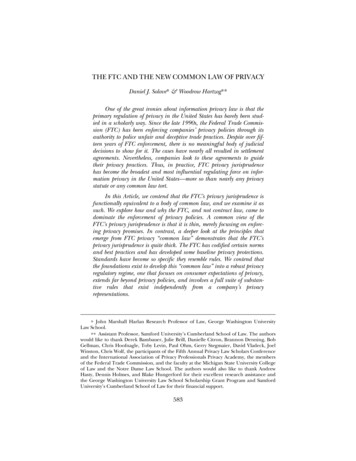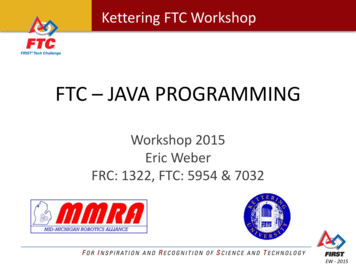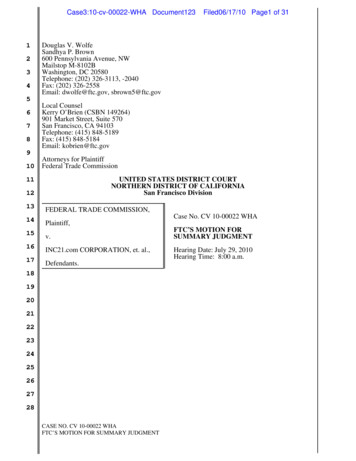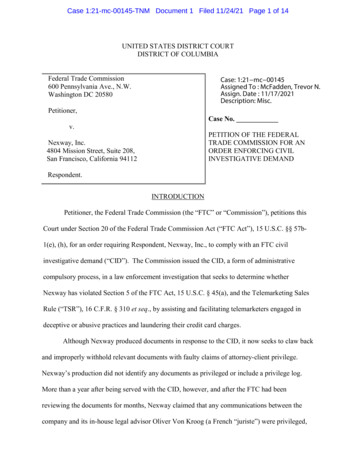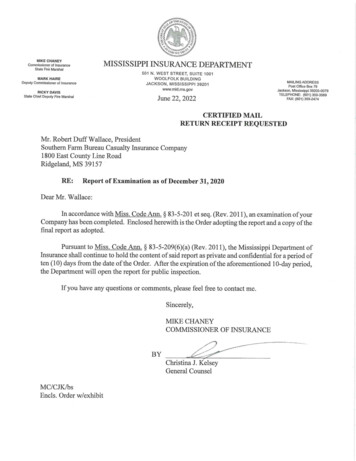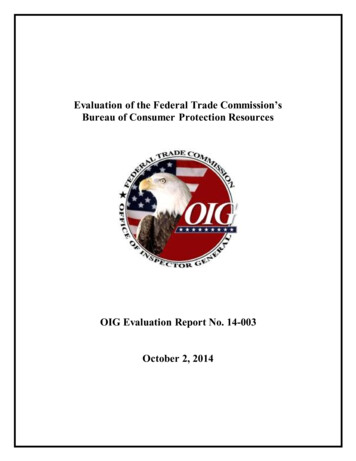
Transcription
Evaluation of the Federal Trade Commission’sBureau of Consumer Protection ResourcesOIG Evaluation Report No. 14-003October 2, 2014
Executive SummaryThe Federal Trade Commission (FTC) has led the way as a consumer protection agencyfor nearly 100 years. The agency enforces laws that prohibit business practices that areanticompetitive, deceptive, or unfair to consumers, and seeks to do so without impedinglegitimate business activity. The FTC also educates consumers and businesses to encourageinformed consumer choices, compliance with the law, and public understanding of thecompetitive process.The impact of the FTC’s consumer protection work is significant. Over the past 3 years,for example, the FTC returned over 196 million to victims of deceptive or unfair practices andforwarded 117 million to the U.S. Treasury. Among the most popular programs established bythe FTC is the National Do Not Call Registry, which allows consumers to opt-out of receivingcertain telemarketing calls. The Registry currently includes over 223 million telephone numbers.The FTC’s Bureau of Consumer Protection (BCP) also reported that in Fiscal Year (FY) 2013 it:achieved a 98% success rate in the cases it brought either in federal court or before anAdministrative Law Judge,received and processed over two million consumer complaints,issued 13 reports on a variety of consumer protection topics, released 256 new consumerand business education publications, and distributed 33 consumer and business educationvideos and audio public service announcements.These accomplishments demonstrate that the FTC has a significant and positive impacton consumer protection. As a result, the agency must make effective use of limited resources bytargeting its law enforcement and education efforts to maximize its desired outcome to protectconsumers. A complex marketplace, ever-evolving fraud schemes, declining budgets, andincreasing workloads require continuous reassessment of management practices in achieving thatobjective.The FTC Office of Inspector General (OIG) performed an evaluation of FTC’s allocationand management of consumer protection resources within the BCP. While other Bureaus andoffices contribute to the FTC’s consumer protection mission, the scope of this review wasprimarily on the BCP. Specifically, this review focused on assessing the BCP’s enforcement andnon-enforcement strategies, goals, policies and procedures. The OIG also interviewed officials inseven other federal, state, and local agencies to identify potential best practices that could beconsidered to further enhance the effectiveness of the FTC’s consumer protection program.In addition, the OIG met with officials in the Bureau of Economics (BE) regarding theBE’s relationship with BCP and contribution to the FTC’s consumer protection mission. The BEcontributes to all aspects of the Commission’s consumer protection mission, including casedevelopment; case review; litigation support; development and review of trade regulation rules,industry guidelines and policy initiatives; design and conduct of research studies, surveys, andspecial projects; development of advocacy projects; economic and statistical training for BCPand regional office legal staff; international consumer protection missions; organization ofconferences highlighting academic research relevant to the consumer protection mission; andprofessional outreach to academic, government, and industry groups. BE economists also havebeen entrusted with primary responsibility for conducting a million dollar, multi- year studyi
mandated by Congress; worked side-by-side with consumer protection attorneys as part ofinvestigation, research, or litigation teams; provided a quick evaluation of a routine fraud case;and conducted original, policy relevant, consumer research.This evaluation found that the BCP’s strategic planning is a best practice in comparisonto other agencies the OIG examined. In fact, strategic planning at the Bureau and agency level isnoteworthy compared to other agencies. This evaluation also identified opportunities, ifimplemented, that could further maximize consumer protection and enhance an already strategicand successful program. In this report we provide several suggestions for improvement that werecommend the FTC consider, including those highlighted below: Utilizing a more structured methodology for strategic planning, consumer protectionenforcement, and education initiatives. A more formal process to evaluate the universe ofconsumer complaints using defined factors, such as estimated consumer harm oreconomic impact, with assigned weights for each factor, would provide a greaterassurance that the priorities in the BCP’s strategic plan will optimize the pursuit of itsconsumer protection mission. Periodically realigning or “right sizing” BCP resource allocations by taking a baselineapproach for determining how many staff resources should be assigned in each divisionbased on alignment to the strategic and annual planning processes. Continuing to build out the Management Data Dashboard (MDD) to integrate disparatemanagement information systems, including disparate data on the costs of enforcementand non-enforcement activities. Where they do not currently exist, creating timeliness goals and budgets forinvestigations, including goals for common deliverables and milestones, such as the gono go decision. Establishing general written “rule of thumb” guidelines for making enforcementdecisions on cases, which provides general guidance on the types of enforcementactivities to pursue and when. Surveying the users of the Consumer Sentinel to determine if the value it provides iscommensurate with the associated cost. Developing additional tools to systematically collect enforcement and outreach outcomesfor planning and management purposes. This may require a joint effort among thebureaus and/or other consumer protection agencies to identify the best means to measurethe agency’s impact on consumers. Re-evaluating the role of the BE in BCP consumer protection activities and determiningif joint longer term planning and coordination on consumer protection goals andstrategies would be beneficial.ii
Table of ContentsBackground . 1Objectives, Scope, and Methodology. 4Results . 5Recommendations . .13Appendix A – Acronyms and AbbreviationsAppendix B - Report Distribution ListAppendix C - Management’s Response to the Report
I. BackgroundThe FTC is an independent law enforcement agency with both consumer protection andcompetition jurisdiction in broad sectors of the economy. Its mission is to work to protectconsumers by preventing anticompetitive, deceptive, and unfair business practices, enhancinginformed consumer choice and public understanding of the competitive process, andaccomplishing this without unduly burdening legitimate business activity. The agencyadministers a wide variety of laws, such as the Federal Trade Commission Act (FTC Act), FairCredit Reporting Act, and Clayton Act. In total, the FTC has enforcement or administrativeresponsibilities under more than 70 laws. The FTC also enforces rules issued pursuant to theFTC Act or other laws, including the Business Opportunity Rule and the Telemarketing SalesRule.The FTC is headed by a five-member Commission, nominated by the President andconfirmed by the Senate, each serving a 7-year term. The President chooses one commissioner toact as Chair. No more than three commissioners may be from the same political party.The FTC’s mission is carried out by the Bureaus of Consumer Protection (BCP),Competition, and Economics, as well as the Office of the General Counsel, the Office ofInternational Affairs, the Office of Policy and Planning, the Office of the Secretary, the Office ofthe Executive Director, the Office of Congressional Relations, the Office of Public Affairs, theOffice of Administrative Law Judges, the Office of Equal Employment Opportunity, and theOffice of Inspector General.The FTC’s BCP mandate is to protect consumers against unfair, deceptive, or fraudulentpractices. The BCP enforces a variety of consumer protection laws enacted by Congress, as wellas trade regulation rules issued by the FTC. Its actions include individual company and industrywide investigations, administrative and federal court litigation, rulemaking proceedings, andconsumer and business education. In addition, the BCP contributes to the FTC's ongoing effortsto inform Congress and other government entities of the impact that proposed actions could haveon consumers. The BCP is divided into seven divisions:o Division of Advertising Practices- protects consumers from unfair deceptiveadvertising and marketing practices that raise health and safety concerns as well asthose that cause economic injury.o Division of Financial Practices- promotes truthfulness and fairness in the provisionof debt collection, mortgage, credit card, other debt relief services; payday lending;and motor vehicle sales, financing, and leasing.o Division of Enforcement- litigates civil contempt and civil penalty actions to enforcefederal court injunctions and administrative orders in FTC consumer protection cases;coordinates FTC actions with criminal law enforcement agencies through its CriminalLiaison Unit; develops, reviews, and enforces a variety of consumer protection rules;and administers the BCP's bankruptcy program.o Division of Marketing Practices- responds to problems of consumer fraud in themarketplace.o Division of Privacy and Identity Protection- oversees issues related to consumer1
privacy, credit reporting, identity theft, and information security.o Division of Consumer and Business Education- Gives consumers the tools theyneed to make informed decisions and gives businesses the tools they need to complywith the law.o Division of Planning and Information (DPI)- oversees the Consumer ResponseCenter, the Consumer Sentinel, and administers the core financial, administrative, andlitigation support activities of the BCP.In addition to the BCP’s seven divisions, they have eight regional offices. Approximately83% of the FTC’s regional staff are dedicated to the BCP mission.The BCP collects complaints regarding hundreds of issues from data security and falseadvertising to identity theft and Do Not Call violations. The BCP shares these complaints withlaw enforcement agencies worldwide for follow-up and uses them to bring cases either in federalcourt or before an Administrative Law Judge. In FY 2013, 98.6% of all cases filed by the FTCwere successfully resolved through litigation, a settlement, or issuance of a default judgment.Also in 2013, the FTC obtained orders amounting to approximately 297 million in monetaryrelief for consumers to “redress” harm suffered. In addition, the FTC obtains injunctive reliefthat stops the challenged conduct and prevents future harmful conduct.On the education and outreach front, in FY 2013 the BCP: a) released 256 new consumerand business education publications, b) distributed 33 consumer and business education videosand audio public service announcements, and c) issued 13 reports on a variety of consumerprotection topics. Figure 1 illustrates BCP accomplishments and highlights from January 1December 31, 2013.The FTC’s BE also contributes to the FTC’s consumer protection mission. The BEcontributes to all aspects of the Commission’s consumer protection mission, including casedevelopment; case review; litigation support; development and review of trade regulation rules,industry guidelines and policy initiatives; design and conduct of research studies, surveys, andspecial projects; development of advocacy projects; economic and statistical training for BCPand regional office legal staff; international consumer protection missions; organization ofconferences highlighting academic research relevant to the consumer protection mission; andprofessional outreach to academic, government, and industry groups. BE economists also havebeen entrusted with primary responsibility for conducting a million dollar, multi- year studymandated by Congress; worked side-by-side with consumer protection attorneys as part ofinvestigation, research, or litigation teams; provided a quick evaluation of a routine fraud case; orconducted original, policy relevant, consumer research. Approximately 1/3 of the BE’s resourcesare devoted to the FTC’s consumer protection mission.2
Figure 1: BCP Accomplishments and Highlights for 2013CONSUMER PROTECTION'PACTIONSFILED/ ORDERS· POLICY " 9Federal43Redress, Disgorgement,& Permanent Injunction91Civil Penalty13Civil Penalty14Civil Contempt3Workshops& Conferences10Rulemakings Completed 3Reports8TOTAL AMOUNTOF REDRESS &DISGORGEMENTORDERED:TOTAL AMOUNTOF CIVILPENALTIESORDERED:Top 5 Redress Judgments*Top 5 Civil Penalty Cases*Ivy Capital 134 MILMortgage Investors Corporation of Ohio 7.5 MIL--National Fidelity Information Services 3.5 MILNCO Group 3.2 MIL-Pro Credit Group 25.3 MILTime Wamer Cable 1.9 MILGlen E. Burke 2 0 .2 MILN ational Attorney Collection Services 1 MIL Information Management Forum 17 MIL noes not include amounts suspended by the court based oninability to pay; any default judgments are included.American Tax Relief 15 MIL767744 23 27 MILLIONconsumers receivedredress totaling over' t q3
II. Objectives, Scope, and MethodologyThe objective of the evaluation was to review the BCP’s processes for allocating andmanaging resources for its consumer protection programs. Specifically, our review focused onassessing enforcement and non-enforcement strategies, goals, policies and procedures. We alsoexplored best practices in selected organizations with a similar mission. To accomplish ourobjectives we:a) Held discussions with FTC employees and officials in the BCP, the BE, and theFinancial Management Office (FMO);b) Reviewed the policies, procedures, and management reports of the BCP; andc) Interviewed officials at the following agencies for best practices:o The Securities and Exchange Commission (SEC)o The Federal Communications Commission (FCC)o The Office of the Comptroller of the Currency (OCC)o The Consumer Financial Protection Bureauo The Federal Deposit Insurance Corporation (FDIC)o The Montgomery County Office of Consumer Protectiono Office of the Attorney General of Virginia Consumer Protection SectionThe evaluation was conducted in the FTC offices in Washington, D.C. We conducted thisevaluation in accordance with the Quality Standards for Inspection and Evaluations issued bythe Council of the Inspectors General on Integrity and Efficiency.4
III. ResultsA. The BCP’s Strategic Planning Process and Alignment of ResourcesThe FTC has an agency-level strategic plan that serves as the “road map” for theagency’s goals, objectives, strategies, and performance measures over a 5-year period. Similarly,the BCP has an internal 5-year strategic plan to define the program areas to which it will devoteits resources. While strategic planning at both the organizational and bureau level is a bestpractice in comparison to other agencies the OIG visited, we believe the approach could beenhanced by incorporating a documented process that is repeatable over time, aligning resourcesconsistent with the priorities in the plan, and improving management level reporting. Thesesuggested enhancements should give the FTC, the BCP, and interested stakeholders greaterassurance that processes are consistent and consumer impact is optimized.1. Strategic Planning at the Agency LevelThe FTC’s most recent strategic planning cycle was among the most participatory of theagencies we visited. All major components of the FTC were included in the process. All officeswere interviewed and information gathered on their strengths, weaknesses, opportunities, andthreats. This input was consolidated and put into a logic model. Using the logic model as a guide,and with the assistance of a strategic planning contractor, a working group made up ofrepresentatives from across the FTC developed a draft strategic plan. An Executive SteeringCommittee composed of senior agency officials provided strategic level guidance to the workinggroup, reviewed the group’s draft plan, and approved the version forwarded to the Commission.The Commission approved the plan after providing their respective input.While this process is a model for others to follow, it is not formally incorporated into aprocedure manual and therefore is at risk of not being repeatable. One of the officials weinterviewed stated that the most recent strategic planning process was documented through thePerformance Institute Capstone Project. We suggest that this capstone paper describing theFTC’s strategic planning process be incorporated into the agency’s procedure manual so it willbe repeatable in the future.2. Creating a More Structured Process for Strategic Planning in the BCP1The BCP’s current process for strategic planning involves several sources. For example,staff members within each BCP division determine areas they think the BCP should focus onbased on current trends in the market, previous cases, the BCP’s top priority areas, emergingissues and trends, information from news sources, issues from consumer advocacy groups,technical and academic reports and analysis, demographic trends, and referrals from Congress.The BCP also receives input from the BE and the Office of International Affairs. From thisprocess, the BCP’s strategic plan is drafted.1It should be noted that when the agency’s strategic planning process started, the only Bureau that had alreadydeveloped their own strategic plan was the BCP.5
The BCP’s current planning approach is commendable, but is somewhat informal andreliant on professional judgment in assessing the array of factors to consider in establishing itsstrategic plan. We believe the BCP would benefit from having a more formal process foridentifying focus areas. For example, the Office of the Comptroller of the Currency (OCC) has aprocess to identify emerging risks for the banking system and adjust its oversight strategiesaccordingly. The OCC uses quarterly reports called “risk radar screens” that rank risks to thenational banking system according to level of severity. The “risk radar screen” included credit,operational, reputation, strategic, interest rate, and liquidity categories.The BCP could adopt a similar concept as it applies to its consumer protection mandateby employing a methodology that consistently evaluates certain selection factors, such asseverity of impact to the consumer, potential monetary recovery, prior results, political risk,deterrent value, legal precedent, and other factors. An analysis of program areas along thesecategories could drive the BCP’s focus and ensure an appropriate mix of enforcement oreducational initiatives. Each of the selection factors could be weighted differently based on themagnitude of the impact it has on the consumer or priorities defined by the BCP. This type ofapproach would optimize consistency and increase return on investment based on consumerprotection priorities established by the FTC (i.e., consumer redress, the potential deterrent value,establishing a legal precedent, etc.).The BCP also generates reports that are not formally integrated into the strategic planningprocess. For instance, the FTC publishes the top 10 consumer complaints each year. However,this information is only informally considered during the strategic planning process. While theconsumer complaint lists do not necessarily reflect trends in the marketplace because they areaffected by changes in contributors to the database over the years, management could considerincluding the top complaint trends as one of the formal selection factor in assessing the universeof consumer protection issues to which it could devote resources.3. Aligning Resources Based on the Strategic PlanBCP budgets and staffing are typically rolled over from year to year, and eachenforcement division within the BCP has relatively the same amount of resources (see Table 1below). The Director of the BCP indicated that although the number of staff is generally not resetfrom year to year, work is transferred between divisions when needed. While this approachprovides flexibility in assigning work based on current priorities, periodically realigningresources to address long-term goals, objectives, and initiatives would allow the BCP to build agreater depth of expertise and efficiency in those areas over time.We believe the BCP should consider periodically taking a baseline approach to resetresources in conjunction with the strategic and/or annual planning process and make resourcerealignment recommendations to the Commissioners, accordingly. We note that certainspecialized skills throughout agency staff may render such a process particularly challenging, butundertaking such a realignment exercise would provide a greater level of confidence thatresource deployment and utilization among the BCP divisions is providing the maximum returnon investment in consumer protection terms. This approach would be a proactive alignment ofresources, and it would not preclude the BCP from also realigning resources in response to6
workload demands. A robust process for both proactive and reactive realignment of BCPresources would maximize both the BCP’s mission effectiveness and its flexibility.Table 1: Number of Staff across BCP Divisions (May 2014)BCP DivisionOffice of the Director (including BCP Honors Paralegals)Enforcement DivisionDivision of Planning and Information (DPI)Division of Marketing PracticesDivision of Advertising PracticesDivision of Financial PracticesDivision of Consumer and Business EducationDivision of Privacy and Identity ProtectionStaff Count31455042484621484. Consumer Sentinel ResourcesThe FTC collects millions of complaints about companies regarding their businesspractices online, by phone, or by mail. Complaints filed online are completed directly by theconsumer on the FTC website. The Consumer Response Center (CRC) in the DPI processescomplaints received by phone and by mail. The complaints may include the consumer’s contactinformation, the type of product or service involved, information about the company or seller,and details about the transaction.The CRC enters these complaints into FTC’s secure online database, the ConsumerSentinel, which is an impressive and unique investigative cyber tool that provides members ofthe Consumer Sentinel Network with access to the millions of consumer complaints collected. Itis free and available to federal, state, and local law enforcement agencies, and to selectinternational law enforcement authorities. There are currently about 2,100 Consumer Sentinelusers, including approximately 100 FTC staff and 200 non-FTC staff who log into ConsumerSentinel every week. In addition, almost 40 separate law enforcement, local, and federal entitiescontribute data to Consumer Sentinel. Capturing complaints in Consumer Sentinel helps the FTCand law enforcement partners detect patterns of fraud and abuse, which may lead toinvestigations and enforcement actions that eliminate or deter unfair business practices.Maintaining the Consumer Sentinel, the Do Not Call database, and operating the CRCcosts the BCP approximately 12 million a year, plus a dedicated staff of about 14 employees.The OIG did not determine how much of these costs are associated with maintaining theConsumer Sentinel, specifically.The DPI monitors who contributes to the Consumer Sentinel and can tell who uses it andwhen, but there is no data available on the results of any investigations or other successfuloutcomes based on information obtained through Consumer Sentinel. The BCP should considersurveying the users of the system to determine if the value it provides is commensurate with theassociated cost. While informal surveys provide a degree of feedback on user satisfaction with7
the database, more information on the outcomes that have been realized by the ConsumerSentinel users would further justify costs that the FTC incurs to maintain the system.The DPI also prepares reports from the Consumer Sentinel, such as the “top violators”report and the “surge” report, to identify emerging consumer complaint trends. These reports areprovided to the BCP divisions. However, there is no formal process to obtain feedback todetermine if these reports add value or are used to help drive case selection. If these reports arenot useful or only marginally useful to the divisions, resources could be redirected. If so, oneoption to consider is the establishment of a small team (i.e., think tank) to conduct drill downanalyses of the data in Consumer Sentinel and integrate the results more directly into theplanning processes at both the bureau and division levels.One of the external agencies we selected to determine if they had any best practices wasVirginia’s Office of Attorney General. We found that their website provides guidance toconsumers on where to file various types of complaints, including those outside the Office ofAttorney General’s jurisdiction. The FTC website provides good information and tools for filingcomplaints with the FTC, but could provide consumers more information on other entities thatalso may have jurisdiction over complaints. While the FTC receives only a small number ofcomplaints that are misdirected, we suggest the FTC consider enhancing its website to helpdirect consumers to other entities with appropriate jurisdiction over their complaints, analogousto Virginia’s Office of Attorney General approach. This would not only provide a valuableservice to consumers, but also potentially improve the efficiency of FTC operations byprecluding misdirected complaints.5. Management ReportingThe FTC has a Management Data Dashboard (MDD) that provides financial reports andcertain information on staff activity, matters management, etc. While the evolution of the MDDis headed in the right direction, the data collected is from disparate systems that are notintegrated to provide agency leaders with a broad perspective on the status of their operations.For example, at the time this evaluation was performed, staff hours charged to an investigationwas available, but not the contract, travel, or other costs associated with an investigation.Integrated data on costs would better equip agency leadership to plan and monitor its work.When data management systems are not integrated and compatible, excessive use of resourcesand inconsistent analysis of program results can occur. In order to make informed decisions andensure accountability, the FTC needs data management systems that can generate timely,accurate, and useful information.The BCP should also consider creating a management reporting mechanism in the MDDsimilar to the Federal Communications Commission (FCC), which is intended for use by theChairman and other senior leaders. The FCC’s dashboard breaks out consumer complaint data ina variety of ways, including complaint sources, top complaint areas, watch lists, biggest movers,emerging issues and numbers of complaints received in various categories.8
B. The BCP’s Case Selection and Management ProcessesGenerally, each enforcement division within the BCP determines which cases it willpursue, manages these cases, and recommends enforcement decisions for each case. Theseprocesses are relatively informal. For example, each litigating Division has biweekly meetingswith the BCP Director to discuss, among other things, investigations and enforcement strategies.The BCP Director, in turn, has regular meetings with the FTC Commissioners to discuss theseissues. Moreover, the Bureau has conducted some ex post facto studies that have proven useful incertain cases. While these processes have resulted in significant and successful cases, we believea more formal approach would ensure that defined factors are consistently applied in selectingcases. This should help the BCP to advance to the next level an already successful consumerprotection program.The work in the Consumer and Business Education (CBE) division is dependent on whatthe enforcement divisions and regional offices are doing since CBE partners with them on thoseefforts. CBE conducts many worthwhile consumer and business education and marketinginitiatives, and consumer satisfaction surveys of CBE’s educational materials demonstratesuccess in those areas. However, there are no formal criteria or guidelines to inform whichinitiatives to select. Most of CBE’s discretionary work is reactive in nature based on marketconditions, consumer complaint data, current consumer issues and trends, and requests fromcongressional offices and state law enforcement partners. CBE obtains feedback on the value ofits products in several ways, including customer satisfaction surveys, monitoring traffic to theFTC website and comments to its blog posts, and tracking the number of publications thatconsumers order.In addition, the role of the BE with respect to the BCP’s mission and performance shouldbe re-evaluated. Based on our interviews with officials in both bureaus, it appears there may beopportunities to improve joint planning efforts and to clarify processes for referring andreviewing consumer protection matters.1. Case SelectionThere are five litigating divisions within the BCP. Case selection is primarily determinedby each division and is usually based on a discussion with the management team within eachdivision. Each division may c
The FTC's Bureau of Consumer Protection (BCP) also reported that in Fiscal Year (FY) 2013 it: . the Executive Director, the Office of Congressional Relations, the Office of Public Affairs, the Office of Administrative Law Judges, the Office of Equal Employment Opportunity, and the . o Division of Consumer and Business Education- Gives .


